![]()
![]()
![]()
Use LEFT and RIGHT arrow keys to navigate between flashcards;
Use UP and DOWN arrow keys to flip the card;
H to show hint;
A reads text to speech;
50 Cards in this Set
- Front
- Back
- 3rd side (hint)
|
Isostasy |
Crustal movement up an down to to weight. |
|
|
|
Tectonic Plate |
Section of Earth's crust. Can be continental or oceanic. |
|
|
|
Plate tectonics |
Study of the movement of seven large plates (tectonic plates) of the Earth's lithosphere. |
|
|
|
Lava |
Molten part of Asthenosphere which breaches above the Earth's surface. |
|
|
|
Magma |
Molten part of Asthenosphere which is contained beneath the Earth's surface. |
|
|
|
Igneous rock |
Cooled volcanic rock. E.g. Granite, basalt |
|
|
|
Sedimentary rock |
Hardened sediments. E.g. Sandstone, limestone |
|
|
|
Metamorphic rock |
Sedimentary or igneous rocks that are subjected to high temperatures and pressures. E.g. Gneiss (from granite) Quartzite (from sandstone) |
|
|
|
Pangaea |
Super-continent made of all the continents over 220 million years ago. |
|
|
|
Gondwanaland |
Supercontinent comprising of South America, Africa, India, Oceania, and Antarctica. Over 150 million years ago. |
|
|
|
Rifting |
Splitting apart of a continental plate. e.g. East African rift zone |
|
|
|
Graben |
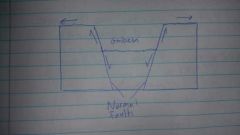
Block of Earth's crust sinks with normal faults on both sides. |
It's graben cause it's slippin |
|
|
Horst |

Raised block of Earth's crust between two faults. |
Horst saddle? |
|
|
Continental Shield (Craton) |
Interior stable portion of crust composed of ancient crystalline rock. |
|
|
|
Anticline |
When a flat section of rock is compressed into a ridge. |
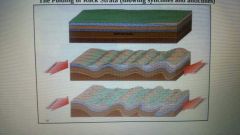
|
|
|
Syncline |
When a flat section of rock is compressed into a through. |
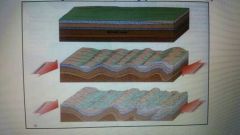
Help, I'm syncing |
|
|
Richter scale |
Logarothmic scale used to measure amplitude of seismic waves. Invented in 1935. |
|
|
|
Earthquake epicenter |
Point on the surface of Earth above the earthquake Focus. |
|
|
|
Earthquake focus |
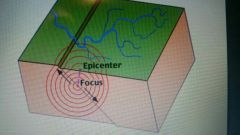
Point where the earthquake actually occurs. |
|
|
|
Seismic gap theory |
A seismic gap is a segment if an active fault which has not slipped in a while compared to other segments in the structure. Over long periods of time, the segments on the same structure should experience equal displacement (slip). A seismic gap is considered to be more likely to suffer future earthquakes. |
|
|
|
Tsunami |
Series of waves in large lake or ocea caused by earthquakes, volcanic eruptions, etc. |
|
|
|
Cinder cone |
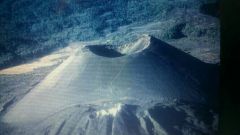
Hill of loose pyroclastic fragments (volcanic clinkers, cinders, volcanic ash, or scoria). |
|
|
|
Hot Spot |
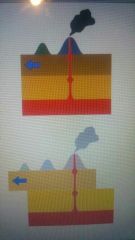
Volcanic regions that are away from plate boundaries. E.g. Hawaiian islands
|
|
|
|
Super Volcano |
A Volcano whose eruptions are thousands of times more explosive than an ordinary volcanic eruption.
E.g. Yellowstone Super volcano (Wyoming)
|
|
|
|
Greenhouse Effect |
Greenhouse gases absorb long wavelength radiation (resinance) radiated by Earth. This is re-radiated in all directions, as opposed to escaping to space if no greenhouses present. |
|
|
|
Primary Greenhouse Gases |
Water vapor Carbon dioxide Methane Ozone (absorbs short wave radiation) |
MeCOW |
|
|
Global Warming Problems |
Rising sea levels Desertification Sensitive ecosystems unable to adapt |
|
|
|
Nome, Alaska |
Polar Climate |
TDHMMMPH |
|
|
Seattle, Washington |
Marine West Coast |
TDHMMMPH |
|
|
Los Angeles, California |
Mediterranean climate |
TDHMMMPH |
|
|
Mexico City, Mexico |
Highland climate |
TDHMMMPH |
|
|
Minneapolis, Minnesota |
Microthermal climate |
TDHMMMPH |
|
|
Boston, Massachusetts |
Microthermal climate |
TDHMMMPH |
|
|
Miami, Florida |
Tropical climate |
TDHMMMPH |
|
|
Atlanta, Georgia |
Humid subtropical climate |
TDHMMMPH |
|
|
Denver, Colorado |
Dry climate |
TDHMMMPH |
|
|
El Paso, Texas |
Dry climate |
TDHMMMPH |
|
|
Houston, Texas |
Humid subtropical climate |
TDHMMMPH |
|
|
3 Differences between Oceanic Crust and Continental Crust |
Oceanic Crust: Denser, made of Basalt, forced downwards during plate convergence.
Continental Crust: Less dense, made of Granite, forced upwards during plate convergence. |
|
|
|
Convergent Plate Boundaries, subduction and orogeny |
When two plates collide with each other.
Subduction: Oceanic collides with Continental crust, called subduction zone. Forms oceanic trench. Orogeny: Two continental plates collide, form mountains. This mountain formation process is called Orogenesis |
|
|
|
Types of Convergence Boundaries (with examples) |
Oceanic-Continental: Subduction. Oceanic plate magma rises to surface causing volcanic eruption. e.g. Andes mountain range (South America) Oceanic-Oceanic: Older, denser oceanic plate subducts newer plate. Magma from lower plate rise, causing volcanic eruption As plates move a chain of island is produced. e.g. Japan. Continental-Continental: No subduction, compression causes extensive folding and faulting of rocks. e.g. Himalaya Mountain Range |
|
|
|
Divergent Plate Processes/Boundaries |
Rifting: Continental plate splits apart. e.g. East African Rift Zone Seafloor Spreading: When two oceanic plates move away from each other, magma rises to fill void, creating new oceanic crust. e.g. East pacific rise |
|
|
|
Transform Plate Boundaries |
When two plates slide past one another, usually without volcanic activity. e.g. San Andreas Fault |
|
|
|
Composite (Strata) vs. Shield Volcanos |
Composite (strata): Cone shaped, very violent, not much lava. e.g. Mt. Fiji Shield: Dome shaped, gentle, lots of lava. e.g. Mauna Loa (Hawaii) |
|
|
|
3 Active Volcanos in Pacific NW |
Glacier Peak Mt. Adams Mt. Baker Mt. Rainer |
|
|
|
How many extictions? |
6. The sixth extinction is unique because it is the only one caused by a living organs (humans). |
|
|
|
How did humans contribute present great extinctios? |
Habitat destruction Introduction of non-native species Pollution Over exploitation Disease |
get HIPOD |
|
|
Rapa Nui (Easter Island) |
Polynesians came over, it was a lush island with diverse populations of fish, vegetation, trees, birds. Over exploitation, deforestation, introduction of chickens, rodents, and overpopulation caused depletion of natural resources of the island. Population of the island peaked, and resources depleted, causing internal tensions and tribal wars. Population decreased to 1000, and stabilized. No more trees remained, exposing land to intense heat, further destroying vegetation. Population survived on snails and some chickens. No trees = no canoes = no escape from island |
|
|
|
Minnesota future climate |
Winters like Chicago Summers like Kansas |
|
|
|
Most destructive earthquake recorded |
Chile |
|

